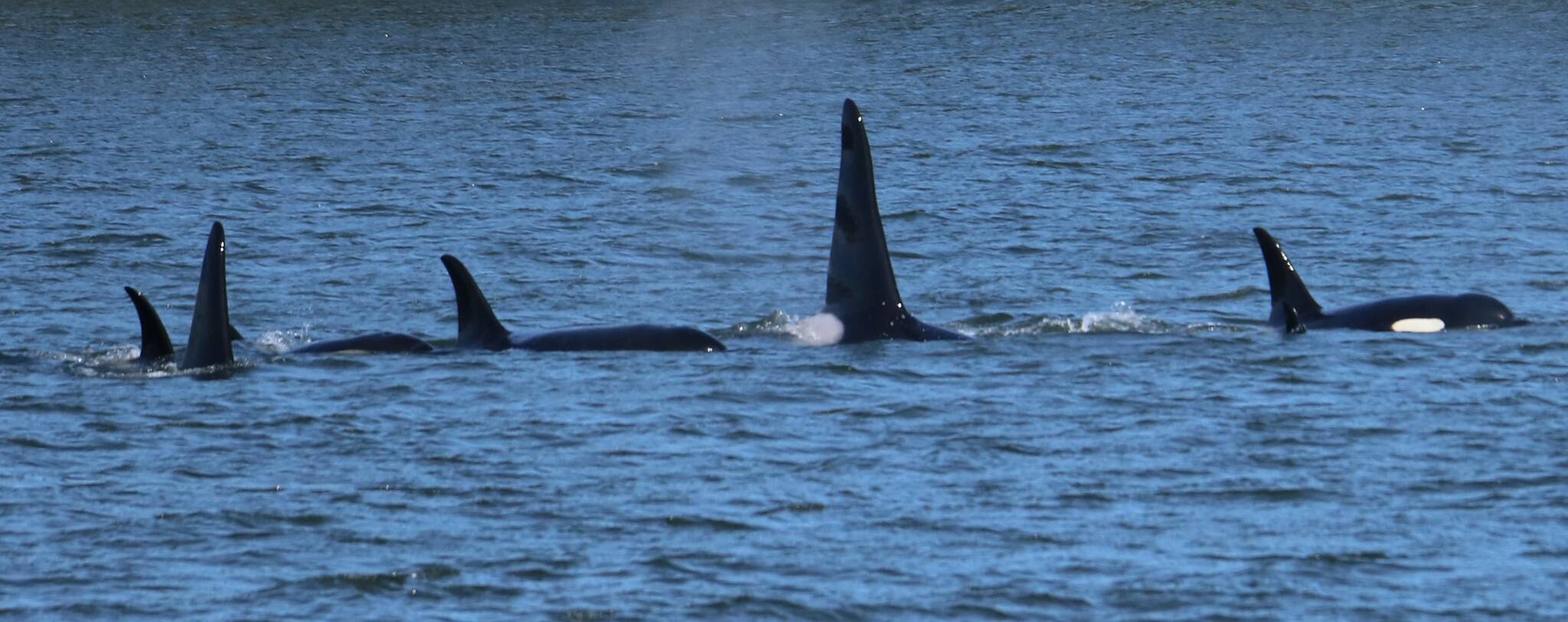The highlight of our Berners Bay cruise with Audubon was sighting a pod of orcas, calmly swimming back and forth close to a gravelly beach. There were perhaps five or six individuals in the group: a male with a tall dorsal fin, probably an adult son of another sizable individual (presumably the mother), and an assortment of smaller ones. Orcas live in matriarchal groups: a female with one or more generations of offspring. An old female, past producing babies herself, often stays with her family group, and research on orcas in Puget Sound has shown that these grandmothers are very useful. They lead the others to good hunting areas, help the others hunt, and sometimes even share fish; in some cases, a grandmother tends a young one while its mother is off hunting. The ‘grandmother effect’ improves the survival of the young ones.
Orcas are distributed very widely around the world, in many oceans. In the North Pacific, they are divided into three distinct types that have different languages and do not interbreed. There’s an off-shore type that eats mostly sharks and other fish, a near-shore type that eats mostly seals and other mammals, and also one that eats fish. Although they specialize on different prey, they all have the capacity of echolocation—sending out bursts of high-frequency sound through a special organ (called the ‘melon’) on the front of the head, and listening for the echoes as the sound waves bounce back. Echolocation allows them to define the shapes and sizes and position of prey and other objects in their environment. For casual navigation, the sounds emitted are of lower frequency.
Orcas and other whales have ears like those of other mammals, consisting of an external ear canal leading to the eardrum and a middle ear with three little bones that transmit vibrations of the ear drum to the inner ear, which houses the sound receptors. But in these highly aquatic mammals, the ear canals are plugged with wax, so reception of air-borne sounds is poor. Instead, water-borne soundwaves are picked up by special parts of the lower jaws and transmitted by the jawbones to the bones of the middle ear.
On a quick trip to Gustavus, a friend and I watched a horde of gulls near the ferry terminal as they foraged on sand lance in the sands exposed at low tide. Sand lance are tiny fish, just a few inches long, with low levels of fat, compared to the fat-rich eulachon and herring. But the gulls were enthusiastically going after them. Bonaparte’s gulls neatly pulled them up by the head from their sandy hideaways; the bigger gulls made less tidy jabs wherever they detected a buried fish and often stole fish from other gulls.
Sand lance burrow into clean, loose sands, usually at night, and emerge during the day to swim in schools and forage on fish larvae, copepods, and other small invertebrates. They appear to hibernate during the winter but begin to be active and feed vigorously in early spring, becoming rather dormant again in summer. The species that occurs here is the Pacific sand lance, which spawns in the intertidal zone on sandy, gravelly beaches, usually in fall. Males and females gather in groups for the action, and females burrow through the sands while releasing their eggs just below the waterline. Incubation time varies enormously, from a couple of weeks to over two months, depending on temperature and other factors. The tiny larvae can live off the lipid-rich egg yolk for some time before beginning to feed on phytoplankton. They usually mature in their second year and can live as adults for several years.
Sand lance are important forage for many species of birds. Among the avid predators are crows and ravens, as observed by another local naturalist (see video: https://youtu.be/9abrKpqikvE ).
On a stroll along a trail in Gustavus, we watched an orange-crowned warbler feeding at willow
catkins, picking miniscule insects from the flowers. It also probed deeply into the flowers and was probably getting nectar. This species sometimes visits our hummingbird feeders, and nectar-feeding seems to be part of its repertoire.
Another Gustavus trail passed around a pond, where we saw ring-neck ducks and canvasbacks. In the mosses near this trail, we saw a female junco pecking, poking, shuffling, and squirming around very actively. She picked up a blade of grass but dropped it immediately, so she wasn’t building a nest (it would have been a terrible choice of location for that). She continued this strange behavior until another female landed next to her and they both took off. Of course we went to look at the place where she focused her activity and found !!ants!! Lots of tiny ants were running around in the torn-up moss. Could she have been eating those little ants? Or could she have been ‘anting’?—the well-known habit of some birds, which stir up some ants and let them run around under their fluffed-up feathers. That distinctive behavior might help deter bacteria and ectoparasites, but the functions are still debated. This junco did briefly fluff her feathers a little and stand with her bill wide open for a bit, as if she were enjoying whatever was happening.
• Mary F. Willson is a retired professor of ecology. “On The Trails” appears every Wednesday in the Juneau Empire.

